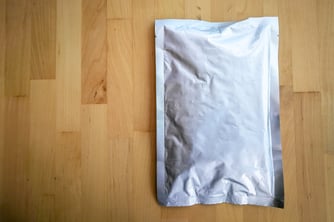5 tips on how to successfully master indoor emissions test
The relationship between automotive manufacturers and their suppliers is characterized by a wide range of quality requirements. Car manufacturers (OEM) have also set strict requirements regarding emissions and odor to protect occupants.
Content
- Emission tests - why bother?
- Emissions testing as a stumbling block for material manufacturers
- Which emission tests are relevant?
- Tip 1 - Test initial samples at an early stage.
- Tip 2 - Factor in possible preconditioning.
- Tip 3 - Avoid contamination.
- Tip 4 - Pack samples correctly.
- Tip 5 - Specify request.
Emission tests - why bother?
For one, car manufacturers must comply with legally binding specifications for vehicle interiors. Secondly, Volkswagen, BMW, Mercedes-Benz, Stellantis, Tesla and others fear that unpleasant odor in the vehicle interior or accumulation of volatile organic compounds, i.e., precipitation of plastic vapors, on the windshield could cause numerous customer complaints.
If unsuitable materials are used in a vehicle series, a wave of complaints cannot be ruled out. In the aftermath, such cases would be difficult to resolve satisfactorily - and would therefore involve high costs and a great deal of effort, as well as declining customer satisfaction and brand preference in a highly competitive market. Consequently, it is understandable that automotive manufacturers place particularly high value on maintaining self-defined emission targets. After all, standardized testing makes this complaint risk avoidable.
Emissions testing as a stumbling block for material manufacturers
In some cases, the issue of material emissions appears to be an underestimated hurdle that can cause material development projects to fail or be significantly delayed. Manufacturers invest a lot of time and money in the development of new materials, which are crucial for securing the future through innovations in the company.
Material managers on the supplier side are regularly discouraged when, after a lengthy development period, it becomes apparent that approval criteria cannot be met in one or more tests. If the emission specifications are exceeded, approval for sampling, i.e., for the use of the material or component in the vehicle, is at stake. It is possible that development work will remain fruitless for the time being, that financial losses will occur, and that further development cycles will be necessary.
Which emission tests are relevant?
All vehicle interior materials must meet a number of requirements to obtain approval from the OEM. This includes those tests that focus on the evaporation of volatile substances from materials and components:
- Determination of odor behavior (e.g. VDA 270)
- Determination of fogging behavior (e.g. DIN 75201)
- Determination of formaldehyde emission (e.g. VDA 275)
- Determination of VOC emission (Volatile Organic Compounds)
-
VOC/FOG determination by direct thermo-desorption (e.g. VDA 278)
-
Emission chamber testing (e.g. ISO 12219-4)
-
Static headspace analysis (e.g. VDA 277)
-
Determination of material emissions in the microchamber (e.g. ISO 12219-3)
-
VOC determination using the sample bag method (ISO 12219-2)
Tip 1 - Test initial samples at an early stage.
In many cases, it can be beneficial to obtain a picture of the emission values of the material or component at an early stage, before any major development effort is made. The earlier suppliers have their materials and components tested, the lower the risk of a major loss of time and resources if components and materials prove to be "not OK" in tests after a long development phase. Accordingly, costs, time and effort can be minimized by assessing the properties of the component or material at an early stage and adjusting them on this basis. Early testing - not just for material approval, but also earlier in the development process - can accordingly pay off.
Tip 2 - Factor in possible preconditioning.
Preconditioning is often disregarded in the time planning when commissioning emissions testing. In most cases, tests require material samples to be stored for seven days under standard conditions (preconditioning) before the test can be carried out - for example, for variants of VDA 278 (thermal- desorption analysis). To have all the necessary sampling documents available on time and to submit relevant test reports, the preconditioning time should be taken into consideration. This ensures that relevant test results are available for deadlines, e.g., with the OEM.
.jpg?width=333&name=white-gloved-hand-holding-a-camera-lens-top-view-2021-09-03-05-48-39-utc%20(1).jpg) Tip 3 - Avoid contamination.
Tip 3 - Avoid contamination.
Material contamination should be always avoided to avoid risking unnecessarily adverse results. Samples should therefore not be handled with bare hands during collection in production. Instead, clean gloves, such as those made of cotton or other non-emissive materials, should be used. To avoid contamination, storage areas should also always be free of contamination. The choice of shipping packaging can also influence emission results, as Tip 4 points out.
 Tip 4 - Pack samples correctly.
Tip 4 - Pack samples correctly.
A frequent and serious error is the use of improper packaging. Time and again, samples are packaged incorrectly for shipment to the testing service provider - to the detriment of the client. Many packaging types chosen in practice can contribute to the contamination of samples because they emit volatile substances.
This leads to contamination of the actual material sample intended to be tested. Furthermore, improper or leaky packaging could lead to contamination by external influences (environmental substances). As a result, samples may show excessively high emission values - which are not caused by the sample, but by its packaging or impurities. In the worst case, samples could be declared "not OK", although this could have been prevented with the aid of the correct packaging. Accordingly, odorless, emission-free sample packaging should be used for shipping.
 Tip 5 - Specify request.
Tip 5 - Specify request.
To provide suppliers with the best possible support in the automotive approval process, test laboratories and consultants need to know as precisely as possible the context in which testing is to take place. Suppliers ultimately save time and effort, and possibly even additional costs, if they provide additional background information right from the start of the test request.
This includes, for example:
- What kind of component is it exactly?
- Where should it be used?
- Is it an initial sample?
- Has the material or component already been tested?
- Which OEMs do you want to achieve approvals for?
The more information is provided, the more likely it is that the process will be completed quickly and without problems. Ideally, the material or component requirements and approval criteria should be known.
But don't worry - if questions do arise about the material approval process, emissions testing or related topics, simply contact an emissions expert.






